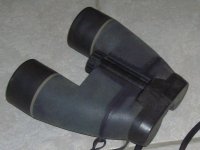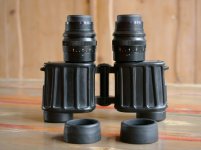My conclusion of this review and comments re. the Swarovski 7x42 Habicht is that what we have here is a very specialized instrument. It simply is too compromised and biased even to be called a good tool for birding. This of course doesn't mean that it can't be used for birding tasks. One can go birding with the Swarovski 7x42 Habicht for sure, but this applies to other specialized instruments like opera glasses, U-boat Ferngläser and catadioptric telescopes as well.
I don't want to discredit the attention given here to the Habicht however. It certainly makes sense to discuss instruments like this on this forum. Just because they don't fit the norm, and represent some extreme in design, we can gain valuable insights from them. At this point please allow me to draw your attention to a quite different but equally specialized binocular, the KOMZ 7x30. This Russian military individual focusing instrument, infamous for its strong yellow colour cast, could very well be just as good on resolution than the Habicht. Here however, we have a truly fine 8.5 deg. (150/1000m) RFoV built in, and great transparancy (others would say sharpness) across the whole (!) viewing circle. So it is possible to have superb resolution, great field of view and a massive sweet spot in a 7x binocular? Yes, but one has to pay for these qualities with gigantic oculars, lots of glass and so, weight.
BTW, I have been birding with this ugly masterpiece several times.
Renze







